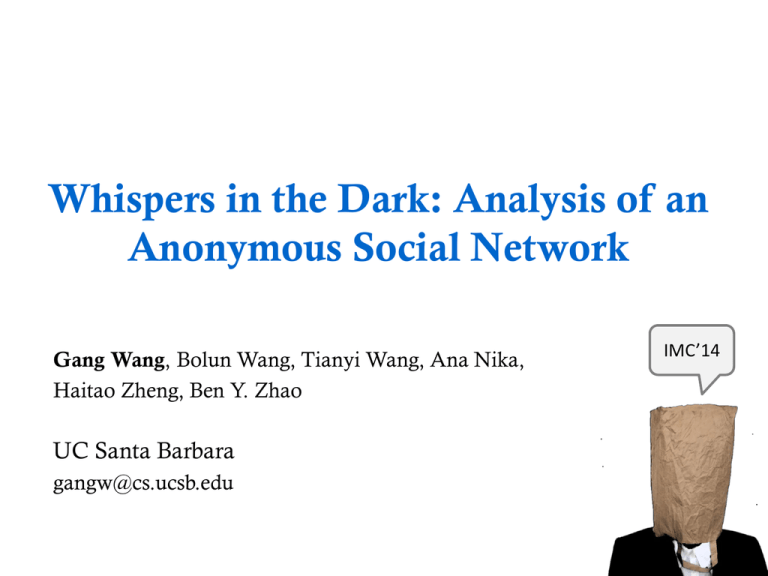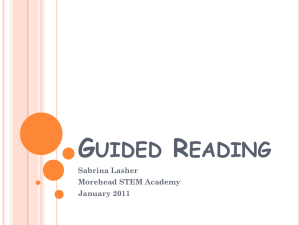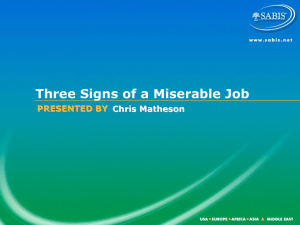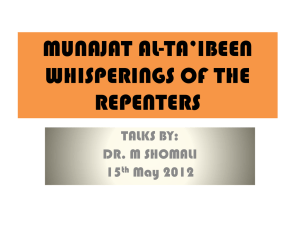
Whispers in the Dark: Analysis of an
Anonymous Social Network
Gang Wang, Bolun Wang, Tianyi Wang, Ana Nika,
Haitao Zheng, Ben Y. Zhao
UC Santa Barbara
gangw@cs.ucsb.edu
IMC’14
Concerns of Using Online Social Networks
• Users cannot speak freely in online social networks
– User profile is linkable to real-world identity
– Online actions can cause serious consequences
1
Whisper Anonymous Social Network
• Whisper, an anonymous social app
– Online profile unlinkable to real identity
– Express freely without fear of retaliation or abuse
o
o
Share stories, seek advice, express complaints
Whistleblowers, teenagers avoiding bully
– Interact with people anonymously
– > 3 billion monthly page views, 2014
• Part of wave of new, anonymous social networks
– SnapChat, Secret, Yik-yak, Wickr, Rooms (Facebook)
2
Key Features
• No personally identifiable information
–
–
–
–
No real names, only nicknames
No user profiles (phone#/email)
No explicit social links
Moderate content to make sure users
don’t reveal their identity
• Post whisper messages
– Topics including relationships, family,
work, religion, politics, sex, etc.
– Secrets, confessions
3
Our Goals
• Understand how anonymity affects user behavior
in anonymous social networks
– How is Whisper’s network structure different from
existing networks like Facebook and Twitter?
– How does anonymity impact the friendships between
users and user engagement over time?
– Implications on user anonymity and privacy
4
Outline
• Motivation
• Dataset and Whisper Network
– Data Collection
– Basic Network Structure
• User Engagement and Stickiness
• Anonymity and Privacy in Whisper
• Conclusion
5
Whisper Functions and Data
Nickname and a
(rough) location
Public whisper lists
• Latest: all recent whispers in the network
• Nearby:
whispers recent
in local whispers
area < 40 miles
System-wise
• Popular: whispers received many replies
• Featured: editor-picked whispers
Whisper and replies
are public data;
Chatting is private
6
Data Collection
• Crawled the “latest whisper” stream for 3 months*
– All public messages from February to May 2014
– 9,343,590 original whispers, 15,268,964 whisper replies
– 1,038,364 unique userIDs
Global universal identifier (GUID)
Link the same user’s data over time
• Interacted frequently with Whisper
– In-person meetings to get data collection permission
– Whisper removed GUID in June 2014
*Data collection with Whisper’s permission, IRB approved
7
Basic Analysis: Interaction Graph
Whisper graph has high dispersion
Interact with a wide range of strangers
• How do users interact with each other with no explicit
social links?
Existing social networks:
Interact with a fixed set of friends
• Interaction graph: Whisper vs. Facebook and Twitter
– Users are nodes, edges represent user interaction
– 3-month time window for all three graphs
VS.
Whisper
Graph
Interact.
Event
Nodes
Edges
Avg.
Degree
Clustering Avg. Path Assort.
Coefficient Length
Whisper
Replies
690K
6531K
9.47
0.033
4.28
-0.011
Facebook Wall Posts
707K
1260K
1.78
0.059
10.13
0.116
Twitter
4,317K 16972K
3.93
0.048
5.52
Retweets
Facebook
-0.025
8
Persistent Friendship
• Persistent user pairs (strong ties) are extremely rare
Interactions
across
Whispers
Interactions
of Total
Number
– Only 7.7% user pairs interacted multiple times (out of all edges)
– Majorities are weak ties, talked once, never again
– Lower bound of user interactions (no data on private messages)
50
10000
40
1000
Majority30of user-pairs have weak relationships:
short-lived, with few interactions 100
20
10
10
1
0 7 14 21 28 35 42 49 56 63 70 77
User Pair
Lifespan
(Day)
Time Between
First
and Last
Interaction (Days)
9
Do Communities Exist?
• Community detection on Whisper interaction graph
– Modularity-based approaches: Louvain and Wakita
– Resulting modularity: Louvain (0.492), Wakita (0.409)
• Modularity > 0.3 community structure
– Facebook (0.63), Youtube (0.66), Orkut (0.67) [IMC’09]
– Whisper has weak community structures
Even though users don’t have persistent friends, they
still form communities
10
Why Do Users Form Communities?
• Intuition: users interact with nearby users (via nearby list)
• Validation: whether community membership correlates
with geographic location
– Example community of 28,342 users, its top 4 regions are
o
California (62%), Texas (1.5%), England (1.2%), Arizona (0.9%)
• Users within a community likely from the same region
Percentile of
Communities
1st
Region
2nd
Region
3rd
Region
4th
Region
50-percentile
52%
3.9%
1.5%
1.4%
70-percentile
45%
1.4%
1.3%
1.3%
90-percentile
32%
0.9%
0.9%
0.8%
Users form communities based on geolocation
11
Outline
• Motivation
• Dataset and Whisper Network
• User Engagement and Stickiness
– User Engagement Over Time
– Predicting Future Engagement
• Anonymity and Privacy in Whisper
• Conclusion
12
From Network Ties to User Engagement
• Background: social ties impact network “stickiness”
– Strong ties: close friends, weak ties: strangers
stranger
– Strong ties help keep existing users from
leaving
a more “sticky” network
• Our question: with a network of strangers, how well can
Whisper maintain user engagement over time?
• Evaluate per-user engagement over time
– How long do users stay active?
– Do users turn dormant quickly?
13
How Long Do Users Stay Active?
• User’s active period (normalized)
– “Active” means users still generate new content
Significant
portion
quickly
dormant
– User’s active
period / of
ourusers
monitoring
periodturn
of that
user
•
40
• Bimodal
distribution predict users stay or not?
35
% of Users
30
25
20
15
Users who stayed active
Users who were only active
for the first1-2 days (~35%)
10
5
0
0.05 0.15 0.25 0.35 0.45 0.55 0.65 0.75 0.85 0.95
User’s Active Period (Normalized)
14
Predicting User Engagement
• Binary prediction, whether disengage quickly or not
– Input: user’s data during initial X days
– ML classifiers: Random Forest, SVMs, Bayes, Decision Tree
• Features (20)
–
–
–
–
Content posting volume, frequency (7)
Social interactions (8)
Temporal features (2)
Activity trend (3)
A extensive list of
features, can be
further trimmed
15
Prediction Result (Random Forest)
Top 4 Features produce accurate results
• 10-fold cross validation
on with
ground-truth
dataset
• # of days
> 1 whisper
• #their
of days
with
>days
1 reply
–
Classify
users
using
first
X
of data
1-day data already• has
94%
Accuracy
Is posting volume decreasing?when
75% of accuracy• # of totalpredicting
engagement
posts
Accuracy (%)
100
90
All Features
Top 4 Features
80
70
60
50
•
•
Whisper
users
likely to14leave
1 Day can 3identify
Day
7 Day
Day
Increase user Data
engagement
using
From Users’
Firstother
X Daystools
30 Day
16
Outline
• Motivation
• Dataset and Whisper Network
• User Engagement and Stickiness
• Anonymity and Privacy in Whisper
• Conclusion
17
Privacy and Anonymity in Whisper
• Existing mechanisms to prevent PII leakage
– No personal information is collected (no real name, phone# or
email address)
– Server only stores public whispers, private chats stay on the phone
– Noise is added to user GPS before sending to Whisper’s servers
• Worst case: attacker compromises servers and obtains data
– Much more external data needed to de-anonymize users
Whisper
?
18
Location Tracking Attack
• Tracking whisper users’ locations
– Pinpoint current location: error < 0.2 miles
– Allow attackers to follow (stalk) users
• How to attack
– “Nearby list” shows whispers by distance
– Triangulate user location using distance measurements
– Reverse-engineer Whisper’s noise function
• Key problem: lack of GPS authentication
– Unlimited # of queries from any location (fake GPS input)
– Use statistics to overcome noise
19
An Example Attack
Whisper: “Get more beer!”
Attack fully automated with forged GPS
• Query “distance” to the victim
• Navigate to victim step by step until convergence
Triangulate target location!
Attacker
Whisper: “BZ is away in
Dublin, party in the lab!”
Location converged!
Victim
Distance Query
More
Details
Fixed by Whisper
20
Summary
• The first large-scale measurements on Whisper
• User interaction has high dispersion, difficult to build
persistent friendship
• User engagement shows bimodal distribution, future
engagement can be predicted by early-day data
• Anonymous apps can still leak personal information
– Location: once shared with the app, has the risk of leaking
– No reliable GPS authentication, attacker can query any locations
21
Thank You!
Questions?
22
References
• [COSN’13] GARCIA, D., MAVRODIEV, P., AND SCHWEITZER,
F. Social resilience in online communities: The autopsy of friendster. In
Proc. of COSN (2013).
• [IMC’09] KWAK, H., CHOI, Y., EOM, Y.-H., JEONG, H., AND
MOON, S. Mining communities in networks: a solution for consistency
and its evaluation. In Proc. of IMC (2009)
23








